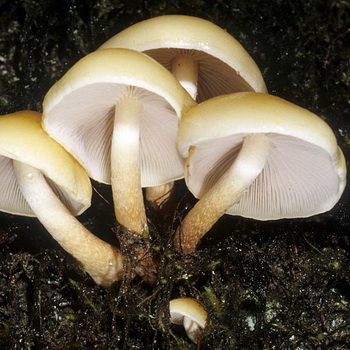Gray lamellar honey fungus: photo and description of the fungus hypholoma capnoides
 Picking mushrooms is an exciting and enjoyable activity for everyone who wants to take a break from the bustle of the city. Noble mushrooms such as porcini, boletus, boletus are very difficult to find. But honey agarics can grow in any forest, on any trees and at any time of the year.
Picking mushrooms is an exciting and enjoyable activity for everyone who wants to take a break from the bustle of the city. Noble mushrooms such as porcini, boletus, boletus are very difficult to find. But honey agarics can grow in any forest, on any trees and at any time of the year.
However, it is worth noting that even when collecting honey agarics, you need to be careful. In our forests, in addition to edible species: summer, autumn and winter, there are also varieties of false honey agarics. Some of them can be eaten, as they are called conditionally edible, while others are poisonous. Therefore, in order to understand, you need to have some knowledge about the appearance of edible and inedible mushrooms. You should also know where they meet and at what time they grow.
An edible mushroom is considered to be a gray-lamellar honey fungus, which confidently differs from poisonous mushrooms. That is why lovers of "quiet hunting", in addition to knowledge about mushrooms, must have color-sensitive eyesight. We suggest that you familiarize yourself with the description and photo of the seroplate mushroom:


Seroplate honey fungus (hypholoma capnoides): photo and description
Latin name:Hypholoma capnoides
Genus: Gifoloma.
Family: Stropharia.
Synonyms: poppy honeydew, poppy honeydew, gray-lamellar false foam, poppy hypholoma.
Hat: diameter from 3 to 7 cm, hemispherical in juveniles and convex-open in mature specimens. Often, pieces of the coverlet remain at the edges of the cap. The hat is hygrophilous, that is, the color depends entirely on the humidity of the air. In dry weather, the cap is dull yellow, richer in color in the middle. In humid weather, it turns light brown with a bright middle. The flesh at the cap is whitish and thin, has a faint smell of dampness.
Leg: gray-lamellar honeydew has a leg with a height of 4 to 8 cm. Its thickness ranges from 0.3 to 0.9 cm. The upper part has a yellowish color, and the lower one is reddish-brown. The shape resembles a cylinder, often curved and with scraps of "skirt".
Plates: honeydew seroplate has thick and adherent plates. In young mushrooms, the plates are yellowish with a white tint; when they grow up, they become the color of a poppy seed.
Spreading: grows only on stumps, dying trees and roots hidden in the soil. It is a frequent visitor to conifers, especially spruces and pines. Grows easily in lowlands and high in the mountains. The entire temperate zone of the northern hemisphere abounds in this type of mushroom. Honey mushrooms are collected from April to October, and sometimes, if the winters are warm, then in December.
Edibility: honeydew seroplate Hypholoma capnoides is an edible mushroom similar to summer honey fungus. Only overripe specimens have a musty odor of dampness. Young individuals smell pleasant, their smell resembles a forest aroma, combined with the smell of earth.
When to collect seroplate mushrooms and what to cook from them
Mushroom pickers with experience call the seroplate honeydew "the second summer honeydew", it belongs to the 4th category. A wide variety of dishes can be prepared from it, they can be salted, dried, pickled. Before use, the honeydew honey should be boiled in salted water for 15-20 minutes. In addition, experts recommend collecting only the caps from this fruiting body, since their legs are very hard, similar to rubber. Look at the photo of the gray-lamellar honey fungus, which is often found in the forests of all Russian regions:


Mushroom pickers are used to collecting only 3 types of edible mushrooms: summer, autumn and winter. However, there is such a mushroom, which is called a false honey fungus. It is an edible mushroom, although many people bypass it. Its main problem is that it looks like poisonous and inedible mushrooms.
Very often, false honeydew is called poppy honeydew or seroplate, as well as poppy hypholoma. These mushrooms can be eaten in the same way as ordinary edible mushrooms, but only after heat treatment. And most importantly - do not pick overripe mushrooms, because they have absolutely no taste.
All mushrooms, including seroplate, can be harvested from spring to late autumn. They grow mainly on stumps, dying trees, wind-blown trunks and fallen branches. Sometimes they can be found right on the ground. However, this does not mean that they grow there directly on the soil. Apparently, under the surface of the earth there are roots from some stump or tree.
If you decide to collect gray-lamellar false fungus, be careful - this mushroom is very easy to confuse with sulfur-yellow false foam, which is considered dangerous. However, poisonous mushrooms have green plates and taste very bitter.
The most important factor in picking mushrooms is always a single rule: pick those mushrooms that you are sure of. If you do not have color photographs of all edible mushrooms with you, go to the forest with a knowledgeable person with experience in this matter.










